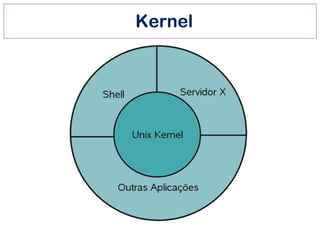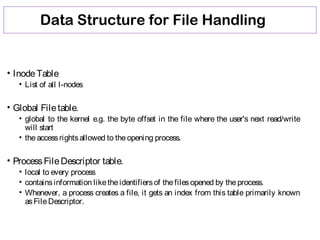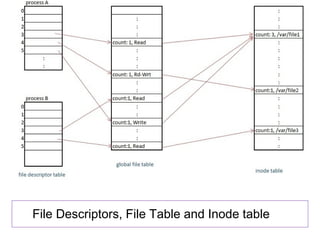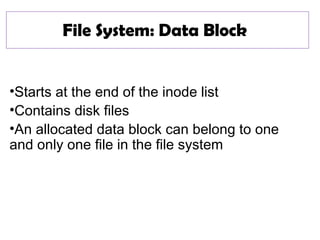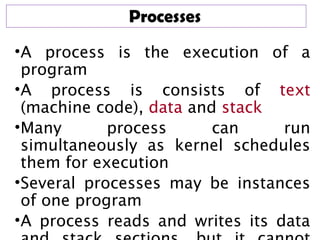Kernal
- 1. Kernel
- 2. Kernel Architecture (UNIX) Library hardware File Subsystem character block Hardware control Buffer Cache system call interface Device driver Inter process communication Scheduler Memory Managemen t Process Control Subsystem User program User level kernel level User level kernel level
- 3. What Is An Inode? • An inode (index node) is a control structure that contains key information needed by theOSto accessaparticular file. • Several file names may be associated with a single inode, but each file iscontrolled by exactly ONE inode. • On the disk, there is an inode table that contains the inodes of all the filesin thefilesystem. • When a file is opened, its inode is brought into main memory and stored in amemory-resident inodetable. 3
- 4. Data Structure for File Handling • InodeTable • List of all I-nodes • Global Filetable. • global to the kernel e.g. the byte offset in the file where the user's next read/write will start • theaccessrightsallowed to theopening process. • ProcessFileDescriptor table. • local to every process • containsinformation liketheidentifiersof thefilesopened by theprocess. • Whenever, a process creates a file, it gets an index from this table primarily known as FileDescriptor.
- 5. Interaction Between Tables With An Example • ExamplE: • procEss a: fd1 = opEn("/var/filE1", o_rdonlY); fd2 = opEn("/var/filE2", o_rdWr); fd3 = opEn("/var/filE1", o_WronlY); • • procEss B: fd1 = opEn("/var/filE1", o_rdonlY); fd2 = opEn("/var/filE3", o_rdonlY);
- 6. File Descriptors, File Table and Inode table
- 7. Explanation Of Figure •Each o pe n() returns a file descriptor to the process, and the corresponding entry in the user file descriptor table points to a unique entry in the global file table even though a file(/var/file1) is opened more then once. •These global file table entries map to the in-core inode table entry. Every opened file has a unique entry in the global file table and the user file descriptor table but kernel keeps only single entry per file in the in-core inode table. •Separate entries are created in user file descriptor and global file table, but only the reference count is increased in the inode table.
- 8. File System •A file system is consists of a sequence of logical blocks (512/1024 byteetc.) •A filesystem hasthefollowing structure: Boot Block Super Block Inode List Data Blocks
- 9. File System: Boot Block •The beginning of the file system •Contains bootstrap code to load the operating system •Initialize the operating system •Typically occupies the first sector of the disk
- 10. File System: Super Block •Describes the state of a file system •Describes the size of the file system •How many files it can store •Where to find free space on the file system •Other information
- 11. File System: Inode List •Inodesareused to accessdisk files. •Inodesmapsthedisk files •For each filethereisan inodeentry in theinodelist block •Inodelist also keepstrack of directory structure
- 12. File System: Data Block •Starts at the end of the inode list •Contains disk files •An allocated data block can belong to one and only one file in the file system
- 13. Processes •A process is the execution of a program •A process is consists of text (machine code), data and stack •Many process can run simultaneously as kernel schedules them for execution •Several processes may be instances of one program •A process reads and writes its data
- 14. Processes • Kernel hasaprocesstablethat keepstract of all activeprocesses • Each entry in the process table contains pointers to the text, data, stack and theU Areaof aprocess. • All processes in UNIX system, except the very first process(process 0) which is created by the system boot code, are created by the fork system call
- 15. Kernel Support for Process Text Stack DataFile Descriptor Table Per Process Region Table Kernel Process Table Kernel Region TableA Process U Area
- 16. Context Switch •When the kernel decides that it should execute another process, it does a context switch, so that the system executes in the context of the other process •When doing a context switch, the kernel saves enough information so that it can later switch back to the first process and resume its execution.
- 17. Mode of Process Execution • The UNIX process runs in two modes: • Usermode • Can access its own instructions and data, but not kernel instruction and data • Kernel mode • Can access kernel and user instructions and data • When a process executes a system call, the execution mode of the process changes from user mode to kernel mode • When moving from user to kernel mode, the kernel saves enough information so that it can later return to user mode and continue execution from where it left off. • Mode change is not a context switch, just change in mode.
- 18. Process States Processstatesare- •Theprocessisrunning in user mode •Theprocessisrunning in kernel mode •Theprocessisnot executing, but it isready to run assoon asthescheduler choosesit •Theprocessissleeping • Such aswaiting for I/O to complete
- 19. Process State Transition 2 4 1 3asleep user running kernel running ready to run system call or interrupt Interrupt return schedule processsleep wakeup return context switch permissible
- 20. Fork System Call • When a process is created by fork, it contains duplicate copies of the text, dataand stack segmentsof itsparent • Also it has a file descriptor table (fdt) that contains references to the same opened files as its parent, such that they both share the same file pointer to each opened file
- 21. Fork System Call Parent Child U Area U Area stack data text stack data Kernel File Table Kernel Region Table Region table Region table

